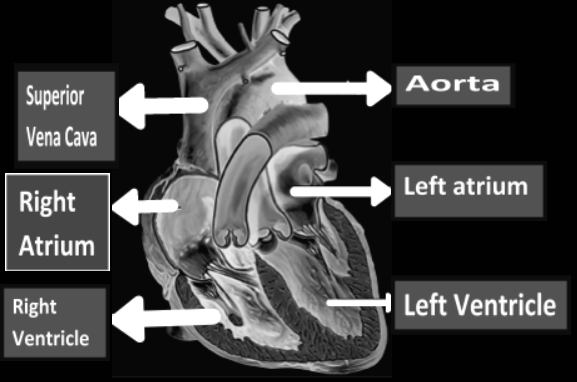
Which has the thickest wall?
A. Right auricle
B. Right ventricle
C. Left auricle
D. Left ventricle
Answer
567.6k+ views
Hint: The heart has four chambers: two atria and two ventricles. The correct chamber gets oxygen-helpless blood from the body and siphons it to the correct ventricle. The correct ventricle siphons the oxygen-helpless blood to the lungs. The left chamber gets oxygen-rich blood from the lungs and siphons it to one side ventricle.
Step by step answer:The left ventricle has the thickest walls since it is the major siphoning office of the heart. The oxygenated blood enters the left chamber, goes through the bicuspid valve and into the left ventricle. The blood leaves the left ventricle through the aortic semilunar valve and enters the aorta. From the aorta, the blood enters the supply routes which convey oxygenated blood to different parts of the body.

The right auricle chamber gets deoxygenated blood from the unrivaled and mediocre vena cavae, and from the coronary veins. Chamber appropriate - found foremost to the crista terminalis, and incorporates the right auricle. So, option A is incorrect.
In the ordinary heart, the solid wall of the right ventricle excluding trabeculations is 3–5mm thick. In this moderately slender wall, circumferential and longitudinal directions prevail.
The left auricle is a small pocket of the heart wall situated on the foremost surface of the left chamber. Starting here, it dives poorly only foremost to the left atrium. So, option C is incorrect.
Hence, option D is correct
Note: The heart comprises four chambers in which blood streams. Blood enters the right chamber and goes through the correct ventricle. The right ventricle siphons the blood to the lungs where it becomes oxygenated. The oxygenated blood is taken back to the heart by the pneumonic veins which enter the left chamber. From the left chamber, blood streams into the left ventricle. The left ventricle siphons the blood to the aorta which will circulate the oxygenated blood to all pieces of the body.
Step by step answer:The left ventricle has the thickest walls since it is the major siphoning office of the heart. The oxygenated blood enters the left chamber, goes through the bicuspid valve and into the left ventricle. The blood leaves the left ventricle through the aortic semilunar valve and enters the aorta. From the aorta, the blood enters the supply routes which convey oxygenated blood to different parts of the body.

The right auricle chamber gets deoxygenated blood from the unrivaled and mediocre vena cavae, and from the coronary veins. Chamber appropriate - found foremost to the crista terminalis, and incorporates the right auricle. So, option A is incorrect.
In the ordinary heart, the solid wall of the right ventricle excluding trabeculations is 3–5mm thick. In this moderately slender wall, circumferential and longitudinal directions prevail.
The left auricle is a small pocket of the heart wall situated on the foremost surface of the left chamber. Starting here, it dives poorly only foremost to the left atrium. So, option C is incorrect.
Hence, option D is correct
Note: The heart comprises four chambers in which blood streams. Blood enters the right chamber and goes through the correct ventricle. The right ventricle siphons the blood to the lungs where it becomes oxygenated. The oxygenated blood is taken back to the heart by the pneumonic veins which enter the left chamber. From the left chamber, blood streams into the left ventricle. The left ventricle siphons the blood to the aorta which will circulate the oxygenated blood to all pieces of the body.
Recently Updated Pages
Master Class 12 Business Studies: Engaging Questions & Answers for Success

Master Class 12 Economics: Engaging Questions & Answers for Success

Master Class 12 English: Engaging Questions & Answers for Success

Master Class 12 Maths: Engaging Questions & Answers for Success

Master Class 12 Social Science: Engaging Questions & Answers for Success

Master Class 12 Chemistry: Engaging Questions & Answers for Success

Trending doubts
What is meant by exothermic and endothermic reactions class 11 chemistry CBSE

Which animal has three hearts class 11 biology CBSE

10 examples of friction in our daily life

One Metric ton is equal to kg A 10000 B 1000 C 100 class 11 physics CBSE

1 Quintal is equal to a 110 kg b 10 kg c 100kg d 1000 class 11 physics CBSE

Difference Between Prokaryotic Cells and Eukaryotic Cells




